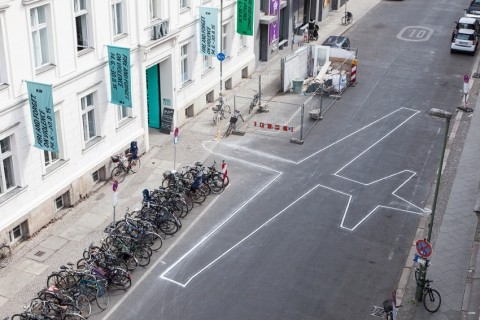Fire and Forget
14 Jun - 30 Aug 2015

James Bridle
DRONE SHADOW, ongoing project, realization following a drone shadow,
installation view, photo: Timo Ohler
DRONE SHADOW, ongoing project, realization following a drone shadow,
installation view, photo: Timo Ohler
FIRE AND FORGET
On Violence
14 June - 30 August 2015
"Fire and forget" comes from military jargon, and is a term for weapons systems that are no longer used in direct combat with an enemy but are launched from a safe distance. The exhibition FIRE AND FORGET. ON VIOLENCE takes the military expression as the starting point for an examination of the conventional ideas about war and force. It is oriented towards the most visible agent of violence: weapons.
FIRE AND FORGET. ON VIOLENCE applies the means of contemporary art to address the long-term effects of these new weapons on the human psyche.The loss of a direct, physical confrontation and the danger for one's own life had created, separates the violent situation itself from affects like reluctance for killing or overreaction, sympathy or hate. What may this mean for the arguments and evidence of political action? Which meaning does this context of the story receive: the memory and forgetting of an outburst, escalation or the prevention of violence? and which interest does art have in all this?
Curated by Ellen Blumenstein and Daniel Tyradellis
On Violence
14 June - 30 August 2015
"Fire and forget" comes from military jargon, and is a term for weapons systems that are no longer used in direct combat with an enemy but are launched from a safe distance. The exhibition FIRE AND FORGET. ON VIOLENCE takes the military expression as the starting point for an examination of the conventional ideas about war and force. It is oriented towards the most visible agent of violence: weapons.
FIRE AND FORGET. ON VIOLENCE applies the means of contemporary art to address the long-term effects of these new weapons on the human psyche.The loss of a direct, physical confrontation and the danger for one's own life had created, separates the violent situation itself from affects like reluctance for killing or overreaction, sympathy or hate. What may this mean for the arguments and evidence of political action? Which meaning does this context of the story receive: the memory and forgetting of an outburst, escalation or the prevention of violence? and which interest does art have in all this?
Curated by Ellen Blumenstein and Daniel Tyradellis
